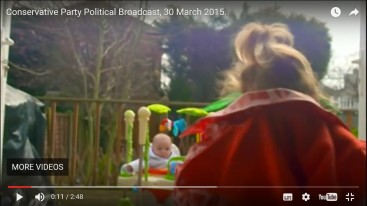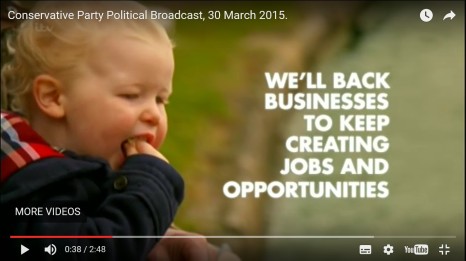Choose a current advertisement or campaign and drawing on the work of Barthes and others, analyse it to show how it derives and conveys its meaning to its intended audience. You will need to apply the principles of simple semiotic, structuralist and post-structuralist analysis.
Introduction
For this assignment I have chosen a Conservative Party Election Broadcast from 2015 as it has many elements of an advert- it’s a large company selling a product through a constructed ‘reality’. Also, having won the 2015 election and in the light of recent events such as the referendum, terrorist attacks, a second (optional) election, ‘strong and stable’ government turning to a ‘coalition of chaos’, and most recently the appalling loss of life in the Grenfell tower block fire, has the reality of the offered vision for our voters really come to fruition? Are other interpretations possible which are more accurate and less dishonest?
The Broadcast;
I have taken the broadcast from the internet at https://www.bing.com/videos/search?q=conservative+party+election+broadcast+2015
where it is freely available to those who have a computer and knowledge of how to use it. The original broadcast was likely meant to attract a particular demographic of established older adults (young ones are traditionally less likely to vote and are less valuable as viewers/consumers). I have included images and both spoken and written text from the broadcast. After introducing some terminology I’d like to take certain frames, and analyse possible meanings contained within them.
What is reality?
In order to analyse the broadcast it will be important to introduce ideas about what reality actually is. It may seem simple, but on closer analysis it is not. Ferdinand Saussure (1857-1913) and Charles Peirce (1839-1914) independently laid the foundations of semiotics, the study of signs, which are essential to how we perceive our reality. Peirce proposed that ‘we think only in signs’ (Chandler, 1994), and it is reasonable to assume that meaning is not simply ‘transmitted’ to us but that ‘we actively create it’ (Chandler, 1994).
Linguistics and semiotics
“Semiotics is the study of everything that can be used for communication: words, images, traffic signs, flowers, music, medical symptoms, and much more.” (Bybee, 2000)
Linguistics is a special case of semiotics. Linguistic meaning is found by decoding words and sentences using the (English) language. Roland Barthes gives a clear analysis of how meaning is built up from a word in Rhetoric of the image (Barthes, 1993 p.33). If we take the word ‘rose’ we can make a simple semiotic analysis (table 1).
Table 1. Semiotic analysis of the word ‘rose’
| Analytical method | ||
| Saussure | Peirce | |
| the physical sound or text | signifier | representamen |
| mental concept | signified | interpretant |
| Physical object | Not included | Object/referent |
| Combination of above | SIGN | SIGN |
| Number of elements in SIGN | 2 | 3 |
Peirce’s method differs from Saussure in several ways. The terminology is different and the Sign concept has 3 elements not 2. Whilst Saussure applied his theory to language, Peirce was interested in how we sense the real world and added a physical object. He also allowed that the mental concept is an interpretation of the signified giving the listener/viewer more input over meaning. His method is more dynamic than Saussure’s signified; the representament-interpretant couple can be iterated successively (one interpretant becomes the representamen for the next) allowing for chains of signifieds, and shifting meanings (Chandler, 1994).
Fig 1. and 2.show images (signifiers) suggesting a reality of a youngster walking into a garden, and a baby in a chair surrounded by toys and photos (the signifieds). The spoken text begins ‘What do I want for my children? I want them to be happy……etc…’ . The linguistic message is built up through the individual words as in table 1. It suggests voters’ children will be secure and happy when the conservatives deliver shrewd economics.
From a young age children learn to interpret visual images of ‘things’ as a representation of reality (Barthes, 1993: p. 36), thus the images are also signifiers at the lowest level of meaning; the denoted message.

Fig. 1 Youtube: John Moore (2015)

Fig. 2 Youtube: John Moore (2015)
Structural analysis
Structural analysis is a study of text as a whole and the kinds of interrelationships/contrasts that the system builds into itself to give it meaning (Bybee, 2000). It is closely related to semiotics. Meaning is built up within a text through the choice of signifiers chosen from a collection of binary opposites.
This strategy tends to favour one choice over its opposite, illustrating the paradigmatic aspect of structuralism. For example male> female, white> black, rich> poor and young>old. Additionally, the syntagmatic aspect says that spatial structure of signifiers is important in conveying meaning and is biased (reading English text from left to right for example) (Pooke and Newall, 2008 p.102). It is now possible to see how several layers of meaning (connoted messages) are constructed in the broadcast using structural analysis and a system of signs as in table 1.
Stuctural analysis of the broadcast
There are many types of media including visual, auditory and tactile. Each has its own characteristics. Images, especially photographic and moving filmed images, tend to be interpreted as very ‘real’ compared to others. The TV images are meant to signify a voter’s real life. The images are accompanied by written text and voices, which are also interpreted as more real, more personable, and allow a much richer range of signs than, say text alone (Chandler, 1994).
The music and voices used throughout this film are very benign. The music is catchy if a little insipid. It has a simple structure; essentially a repeated tune and harmony for each scene, suggesting (ie. a sign) a pleasant wandering between the scenes and families. Spoken text corresponds to the voter’s requirements from a government, and voices are adult representing different geographical areas, origins, nationality, sex and class, a sign that everyone will benefit from voting conservative. Each spoken statement is followed by a ‘response’ from the Conservative party, which is reinforced by the perfect cadence which lands on it. Dominant-tonic harmony is a strong musical sign of stability and strength. All these aural meanings are connoted messages.
At the connoted level meanings begin to multiply quickly. Fig 1 and 2. Shows that technical ‘filmic’ methods have been used to increase the sense of reality (real>imitation). The French windows are opened, the child walks through, and we (the camera) follows. The whole scene (the whole advert too) is in slow motion which means ‘relaxed, gentle and reassuring’. Meaning is transferred through ‘Conservative Blue’, both in the baby’s toys, and in the strange blue haze in the scene (this seems not to be a reproduction artefact- has a camera filter been used here?).
The (simplified) analysis in Fig. 1and 2 might be summarised; the scene uses signifiers of children, babies, educational toys, photos, a suburban garden, relaxation, a benign regional accented voice, gentle movement and music. These signify a successful life, economic wealth, stability, the birth and nurturing of children. These in turn signify (either individually or as a repeated chain) the Conservative ideal, and a life you will get if you vote Tory. Each signified transfers meaning through their hidden opposite-childlessness, difficulty, unintelligible harsh voices, poverty, and change. The addition of text to the images helps to keep the number of meanings under control, through both anchorage and relay (Barthes, 1993: p. 37)
In the park

Fig.3 Youtube: John Moore (2015)

Fig. 4 Youtube: John Moore (2015)
Voiced Text: I want him to grow up in a Britain where there are doors open to him, so he can get on, get a good job………’.
In fig. 3 and 4 we see several signified/signifier couples (signs) which transmit the meanings paternal and pastoral care (the son, dog and ducks), family life and values (leisure time, active paternal engagement), and the importance of a capitalist society for happiness (business and jobs). These hidden biased positions are referred to as discourses.
This scene nicely illustrates Peirce’s three different modes of sign.The linguistic message is symbolic (signifier related arbitrarily to the signified), the video image is both iconic (relation based on likeness), and indexical (the relation is direct) (Chandler, 1994). In fact the infant fulfils all three types simultaneously; indexical via the process of filming (a direct connection between the infant and the image-the unique ‘having been there’ character of photography (Barthes, 1993: p 40); iconic as we interpret the image as a real infant, and symbolic because children and babies hold meanings such as trust, prosperity, and happiness. As we move through indexical, iconic, and symbolic, the signifieds become more ‘arbitrary’ and less ‘motivated’ (the connection between signifier and signified is ‘looser’).
Symbolic signs, the infant, ducks and dogs in the park, dad’s protection, and the importance of businesses and jobs in society, are heavily determined by cultural factors (Chandler, 1994). Our Western culture puts a large value on discourses like a good and stable job, a home, children, and possessions. All these signs and discourses operate via the chosen half of a binary opposition. Arguably other ways of measuring a good and stable life are possible.
Post-structuralist analysis:
Post-structuralism emerged in Paris in the 1960’s as a reaction to Structuralism, through the work of Jacques Derrida, Jean Baudrillard, Michael Foucalt, and Roland Barthes.
Post-structuralism holds that the study of underlying structures is itself culturally conditioned and therefore subject to myriad biases and misinterpretations. To understand an object (e.g., one of the many meanings of a text), it is necessary to study both the object itself, and the systems of knowledge which were coordinated to produce the object.
New World Encyclopaedia (2015)
Post-structuralists rejected the inherent dominance within binary pairs, and allowed a signifier to be emptied and of no fixed meaning New World Encyclopaedia (2015). This deconstructed message represented a different and potentially more accurate view of reality (see my BLOG for a deconstruction of the anthems ‘God save the Queen’ and ‘Jerusalem’ ). To illustrate the process I will investigate the underlying structure and reality by deconstructing the later broadcast scenes which focus on David Cameron, his family and the Tory party (fig 5-8).

Fig. 5 Youtube: John Moore (2015)

Fig. 6 Youtube: John Moore (2015)

Fig. 7 Youtube: John Moore (2015)

Fig. 8 Youtube: John Moore (2015)
Fig 5-7 show the Prime Minister watching his son play football, scoring a goal, and then back at home for the family dinner (the salad bowl resembles a trompe d’oleil Dutch still life-like the shopping basket in Barthes’ analysis of a Panzani advert (Barthes, 1993: p 35). It is east to see the constructed meanings of the signs in these images.
Deconstructing the scenes may reveal alternative truths about life which are not part of conservative ‘brand’. In a stable happy family, it is not necessary for son’s to play football whilst dad watches (male> female), and mum stays at home making the dinner. Daughters could play football, mum’s watch, goals do not indicate success, and the son and dad could be home enjoying more ‘feminine’ pastimes, such as baking or preparing the dinner.
It is also possible that a worthwhile happy family life can be enjoyed by people who do not correspond to the narrow view of normality seen around Cameron’s kitchen table. The family could be mixed race, same sex parented, may be childless, looking after an elderly relative with physical or mental disabilities. This deconstructed analysis questions why some meanings are inherently chosen. A more balanced view will give more space and ‘air time’ to less socially acceptable realities that are possible in the UK. The final scene (fig. 8) shows a union jack, and the take home linguistic message on a conservative blue background. The union flag represents a strong discourse about British history, involving male domination, mercantilism, war, imperialism, colonialism and slavery. A deconstructed view of this image might describe British family life from the point of view of feminism, Queer theory, LGBT society, altruism, pacifism and post-colonialism.
Conclusion
I have shown how this party political broadcast has constructed many meanings in many different ways, in order to create an illusion of reality which might allow an election victory. This version of reality has been contrasted with other versions which are possible in UK society.
These may be more (or less) accurate, honest and real- or they may not be. Some people’s reality will not have corresponded to the vision offered, others’ may have. Probably no ‘fixed’ reality exists, and the best notion of it is multifactorial- involving words, images, signs, physical objects, and the different points of view of lots of different theoretical ‘isms’. However I think this best shot at reality is likely to include, and possibly highlight, those aspects which are hidden, but still detectable within this broadcast.
Illustrations
Fig.1-Fig. 8. John Moore (2015) [Youtube webpage] at https://www.bing.com/videos/search?q=conservative+party+election+broadcast+2015 [accessed 29th June 2017]
References
Barthes, R (1999). ‘Rhetoric of the Image’ in visual culture: a reader. Evans, J and Hall, S (eds.). London. SAGE Publications. P33-41
Bybee, C, 2000. Semiotics and structuralism [online] at http://journalism.uoregon.edu/~cbybee/j388/semiotics.html [accessed 29th June 2017]
Chandler, D (1994): Semiotics for Beginners [online] at http://www.aber.ac.uk/media/Documents/S4B/ [accessed 29th June 2017]
Moore, J (2015) conservative party election broadcast 2015 [Youtube webpage] at https://www.bing.com/videos/search?q=conservative+party+election+broadcast+2015 [accessed 29th June 2017]
New World Encyclopaedia (2015) Post-structuralism [online] at http://www.newworldencyclopedia.org/entry/Post-structuralism [accessed 29th June 2017]
Pooke, G and Newall, D (2008) Art History. Abingdon. Routledge.



















